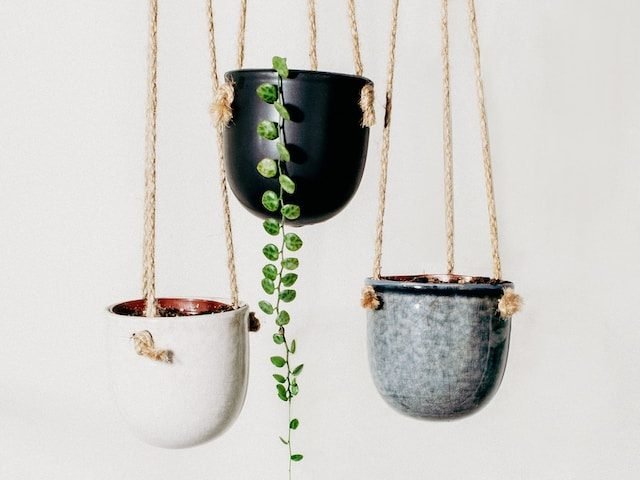
Top trailing houseplants for your hanging planters
There’s something really special about the way houseplants cascade out of hanging planters and baskets and simply we can’t get enough of it! Hanging vines aren’t always neat and tidy but that’s the exact reason we love them as they bring a little bit of wilderness right into your home.
Hanging plants are also great if you don’t have much space as they can be placed on shelves, tables or countertops which means they don’t take up valuable floor space. Below you’ll find our favourite hanging and trailing indoor plants, some easier to care for than others, but all equally as beautiful.

Devil’s Ivy
Epipremnum aureum
These are pretty unique houseplants because they actually prefer lower-light conditions over anything else! That’s where the name comes from, as they are well acquainted with the darkness. If you have a variegated variety, it will actually start to lose its pattern if placed in too much sunlight. So you don’t need to feel guilty about putting a Devil’s Ivy in a shady spot because it will actually love you for it.
They are also pretty hardy plants in terms of their other care requirements. They don’t need complicated watering schedules or specific pruning so are perfect for any new plant parents. You can’t really go wrong with these at all!
When it comes to styling the Devil’s Ivy plant, shelving is where they thrive as it gives it room to cascade dramatically out of the pot. They can be trained to grow upwards by a wall or moss pole so the option is yours.
Find out more in our Devil’s Ivy care guide.
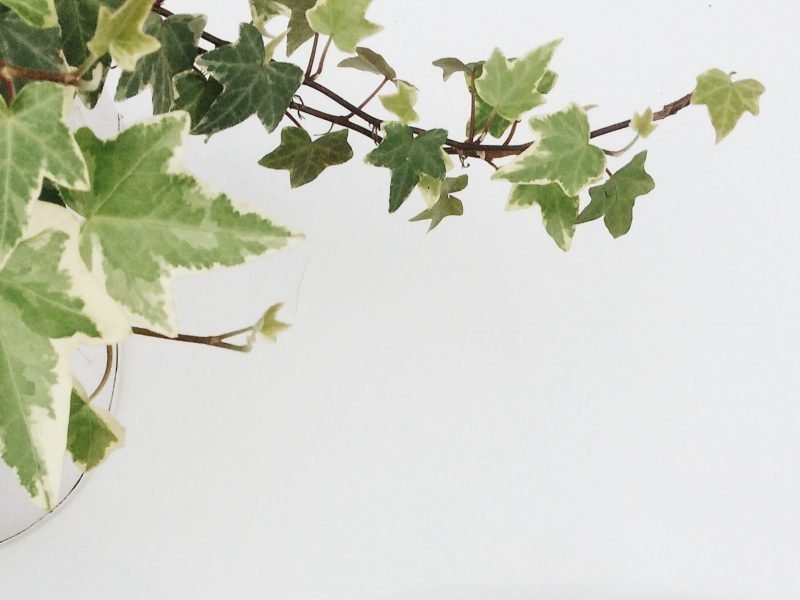
English Ivy
Hedera helix
Although they are most commonly known as outdoor plants, you can very successfully grow an English Ivy indoors as long as you give it enough light. We are obsessed with the white variegated English Ivy but if not given enough sunshine, the new leaves will lose all of that variegation.
Included in the NASA Clean Air Study, the English Ivy is great at removing toxins from the air so we recommend having this around your home. They are also believed to sometimes be able to improve allergy symptoms so as well as looking lush, they have great benefits for us too. They are also super fast-growing plants so you want to place them on a high shelf making sure they have enough space to cascade downwards.
Find out more in our English Ivy care guide.
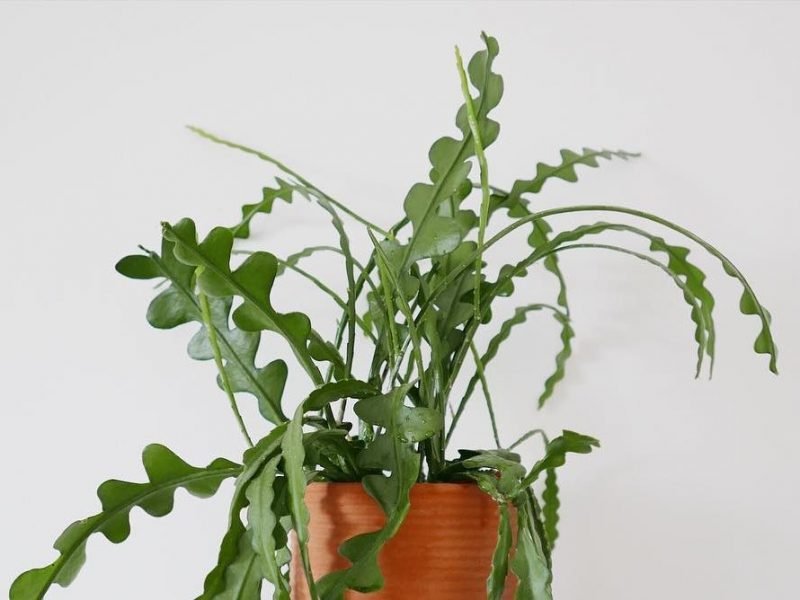
Fishbone Cactus
Epiphyllum anguliger
Their flat zig-zag leaves make the Fishbone Cactus something really special. And they aren’t even super difficult to care for which is a bonus. It’s important to note that the Fishbone Cactus is actually native to the jungles of Mexico rather than a desert. This means the care is slightly different to what you’d expect when you hear the word Cactus. They need a little bit more water and can only deal with some direct sunshine each day.
You’ll be pleased to hear that they are also really easy to propagate and are non-toxic too! The only downside is that they can be a little bit difficult to find but we hope as they continue to grow in popularity that they’ll soon be in every plant shop across the world.
Find out more in our Fishbone Cactus care guide.

Monkey Mask Monstera
Monstera Adansonii
A close relative to the infamous Swiss Cheese Plant, the Monkey Mask Monstera never disappoints. With holes in the middle of the leaves, rather than running to the edges, this plant definitely stands out in a crowd. It can get a little rough and rugged looking as the vines intertwine around each other, but that gives it quite a rustic charm and brings a little bit of the jungle right to your home.
Monkey Mask Monstera plants can be grown with a moss pole if you’d prefer to prop it up, or it can be left to hang down out of the pot, making it adaptable to nearly any space in your home. When it comes to caring for your plant, avoid direct sunshine and super soggy, and make sure to mist the leaves regularly and your plant will be very happy!
Find out more in our Monkey Mask Monstera care guide.

Satin Pothos
Epipremnum pictum Argyraeus
Known for their unique silver speckled leaves, the Satin Pothos is the perfect houseplant for every plant parent as they are super simple to care for. They can grow quite quickly in the right conditions and are very easy to propagate, so cuttings and young plants can make great gifts.
Bright, indirect light and a consistent watering schedule will keep them happy and thriving. Avoiding colder rooms or areas with dryer air will really help in making sure your Satin Pothos will stay healthy all year round.
Originating from southeast Asia these plants will also appreciate a little extra humidity, so spraying them with a mist bottle every now and then will keep them closer to their natural environment.
Find out more in our Satin Pothos care guide.
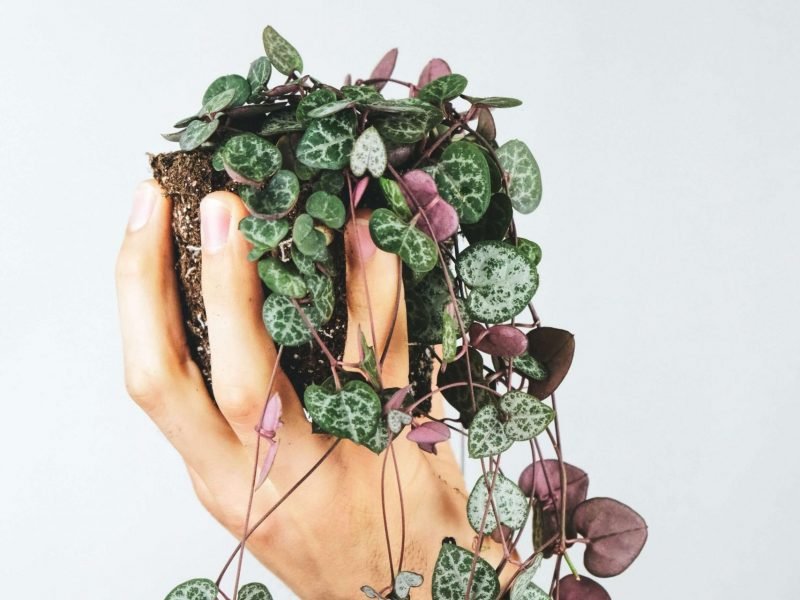
String of Hearts
Ceropegia woodii
Native to South Africa, the String of Hearts should be top on your list for trailing houseplants. You don’t get much more unique than their speckled heart-shaped leaves. The other thing we love about the String of Hearts is that it’s such a fast grower over the spring and summer months, you’ll blink and there will be two new leaves popping out somewhere.
The String of Hearts is a semi-succulent plant meaning they don’t need much water, otherwise, it’ll cause their delicate shallow leaves to rot pretty quickly. Oh, and because they have such shallow roots, you won’t need to repot for a very very long time.
It makes the perfect plant for hanging down shelving, and because its pet friendly, you don’t need to worry about it ever becoming too long!
Find out more in our String of Hearts care guide.
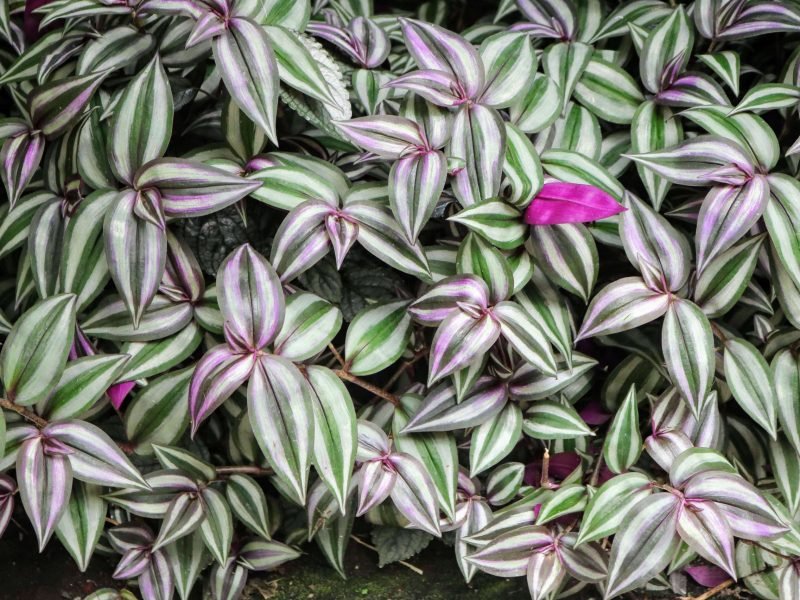
Inch Plant
Tradescantia zebrina
Also known as the Inch Plant, we haven’t yet come across a faster-growing or easier to propagate houseplant. Native to the tropics of Mexico and South America, these plants offer something different with their purple and silvery leaves that transcend out of the pot.
Growing these indoors helps keep their growth more contained whilst still giving that wilderness feel which we love. Caring for these plants is also super easy as all they need is ample light and moderate water. They are quite forgiving though so won’t give up straight away if something’s a little off.
These plants are great for hanging planters or when placed on shelving so you can really make the most of those incredible vines. They can be mildly toxic though so you’ll want to keep them away from pets.
Find out more in our Inch Plant care guide.

String of Pearls
Senecio rowleyanus
It’s not difficult to fall instantly in love with the String of Pearls plant as their incredible small spherical leaves cascade dramatically out of every pot and hanging basket. The String of Pearls is a succulent plant meaning they love a lot of sunshine but don’t need much too water as they are quite sensitive to root rot.
It’s important that you continuously propagate your String of Pearls plant as the vines don’t survive that long. Without any propagation, your plant might only last about 5-6 years but luckily you can just take stem cuttings to regenerate growth.
The thing we love most about the String of Pearls is how quickly it grows during spring and summer. It really makes up for the lack of growth during the darker colder months that’s for sure!
Find out more in our String of Pearls care guide.
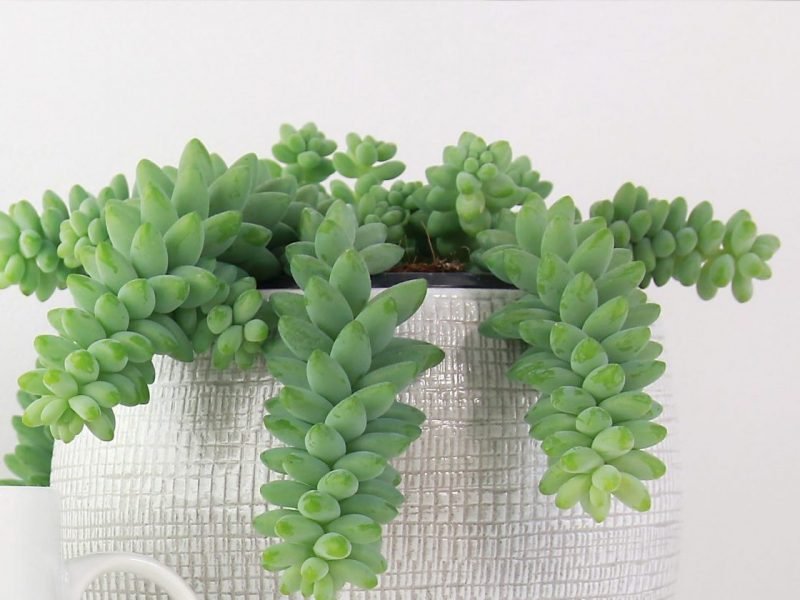
Burro’s Tail
Sedum morganianum
Also known as the Donkey’s Tail Plant, these striking succulents are loved for their delicate leaves that dramatically cascade out of the pot. Native to Mexico and Honduras, they are forgiving to the forgetful waterer as they store water in their leaves (this also makes them quite sensitive to overwatering so be mindful about that) and just need a nice warm sunny spot to be happy!
Their easy care routine does come at a cost, however, as the Burro’s Tail grows pretty slowly throughout the year. Their stems can often reach around 20-25 inches but it’s really important to handle the Burros Tail plant carefully as the stems break off with just the slightest touch. Luckily they enjoy being root-bound so you shouldn’t have to repot it very often and you can really easily propagate any stems or leaves that fall off. They are also non-toxic so great for homes with small children or furry friends.
Find out more in our Burro’s Tail care guide.

Marble Queen Pothos
Epipremnum Pinnatum
There are so many different varieties of Pothos plants, all with slightly different leaf variegation but the Marble Queen is definitely one of our favourites. Getting its name from the cream marble-like variegation on its leaves, it’s an easy-going, hardy and low light loving plant that can adapt to most spots in your home.
The Marble Queen Pothos is a pretty fast-growing plant so make sure you have enough space for it to mature. You can choose to grow them as trailing plants with long cascading vines or vertically by attaching them to a moss pole. Pothos plants are unfortunately toxic so you’ll want to keep them away from pets and small children who might try and nibble on the low hanging leaves.
Find out more in our Marble Queen Pothos care guide.



